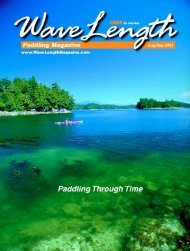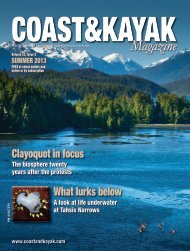Download - WaveLength Paddling Magazine
Download - WaveLength Paddling Magazine
Download - WaveLength Paddling Magazine
You also want an ePaper? Increase the reach of your titles
YUMPU automatically turns print PDFs into web optimized ePapers that Google loves.
PROP ROOTS<br />
For sea kayakers especially, the most notable<br />
things about mangroves are the prop roots<br />
of the red mangrove (Rhizophora mangle).<br />
On low, scrubby mangroves they form a tangle<br />
of wood that can withstand huge storms—<br />
on taller mangroves they become “drop<br />
roots” that come down from branches high<br />
above water. Under the surface, they are excellent<br />
habitat and fascinating to snorkel.<br />
RED MANGROVE SEEDLINGS<br />
On the tree, they look like exotic tropical fruit.<br />
When they fall off they float, horizontally at<br />
first, so they drift away from the parent plant.<br />
After a day or three the root-end gets waterlogged<br />
and sinks, waiting to bump into bottom<br />
to attach to and grow. Remarkably, these<br />
little trees can drift for up to a year and still<br />
successfully “plant” themselves.<br />
SNORKEL ROOTS<br />
Black mangrove (Avicennia<br />
germinans) roots avoid smothering<br />
in dense mud by putting up distinctive,<br />
knobby looking<br />
pneumatophores. Looking like fingers<br />
reaching up from the mud,<br />
they surround the main trunk, radiating<br />
outward in patterns that follow the roots below. Squeeze<br />
one—they have a spongy feel because much of their tissue is<br />
airy, all the better to allow oxygen to diffuse downward.<br />
TANNIC ACID<br />
Like our own red cedars, red mangroves contain tannin, which<br />
makes them unpalatable to most herbivores. Venture deep into<br />
mangrove swamps and the water will likely become a murky<br />
reddish brown, much like a slow moving stream or pond in the<br />
Northwest. It’s best to do your snorkeling on the clearer fringes<br />
of the swamp, not the murky center.<br />
SULFUR<br />
That nasty rotten egg smell you might experience in a mangrove<br />
swamp means that the flooded soil has lost all its oxygen. This<br />
would normally kill just about everything except bacteria which<br />
can use the sulfate in seawater instead, producing stinky hydrogen<br />
sulfide, which is also toxic to plants. Mangroves manage to<br />
survive (and be productive) using their prop roots or snorkel<br />
roots to bring oxygen down to the roots below ground, preventing<br />
them from smothering in the toxic muck.<br />
FRIGATES & EGRETS<br />
Mangrove islands make great habitat for nesting<br />
and resting seabirds. The smaller the island,<br />
the less likely there’ll be any predators,<br />
and certain islands and even specific trees can<br />
be completely covered in birds. Near shore,<br />
egrets will converge on specific trees, while<br />
farther offshore frigates, pelicans, boobies and<br />
other seabirds can easily be spotted drifting above or resting in<br />
the branches of mangroves. Kayaks are a great way to see these<br />
birds as many nesting islands are “no walking” zones.<br />
Checklist 27—Mangrove Mania<br />
CROCODILES<br />
Yes, there just might be crocodiles<br />
lurking in Caribbean mangroves.<br />
Though the alligator is<br />
restricted to Florida and fresh<br />
water (strays don’t last long in<br />
the salt), the American crocodile (Crocodylus acutus) is fond of<br />
brackish and salty mangrove swamps. Though it gets big (rarely<br />
to seven meters!), this species is remarkably shy and nocturnal,<br />
making sightings rare. A night paddle with a flashlight might<br />
reveal those reflective eyes, and juveniles like the one in the<br />
picture can occasionally be found in shallow pools near camp.<br />
SPONGE (FIRE AND CHICKEN LIVER)<br />
Pop into the water and take a look at those red<br />
mangrove roots—they’ll likely be covered in all<br />
sorts of things, including colorful sponges in<br />
blues, purples, reds and yes, even liver colors.<br />
Colonies of these simple, filter feeding animals<br />
use the roots as a base to feed in the passing<br />
currents. Don’t touch the red ones—they’re not<br />
called fire sponges because they’re flammable.<br />
TUNICATES<br />
Though they form colorful encrustations like<br />
sponges, a close look at colonies of bluebell<br />
and lightbulb tunicates will reveal they are tiny<br />
little animals with two siphons. An even closer<br />
(microscopic) look would reveal they are related<br />
to us—in Phylum Chordata.<br />
ANEMONES<br />
Zoanthids and several species of anemone are<br />
common on and among mangrove roots, their<br />
tentacles stretching into the current to catch and<br />
consume passing animals. Though they’re far<br />
to small to catch you or your boat, one or two<br />
species can give you a mild sting if you get too<br />
intimate.<br />
FISH<br />
Fish, especially juvenile fish, love<br />
mangrove roots. Sport fishers cast<br />
along the roots hoping for<br />
bonefish, snook and even tarpon.<br />
As a paddler or snorkeler you’ll likely see schools of silversides<br />
and snapper ducking for cover as you drift by. If you’re lucky, you<br />
might even see rays and the occasional big barracuda.<br />
MANATEES<br />
Everybody loves marine<br />
mammals, even when<br />
they’re big and blubbery<br />
and likely less than brilliant.<br />
These large, elusive vegetarians are a Florida favorite, and<br />
in the wild they (and their Pacific relatives the dugongs) tend to<br />
roam the swampy coastlines created by mangroves. Shy and mild<br />
mannered, they can be difficult to spot—from your kayak look<br />
for a large, dark mass followed by a paddle shaped tail, or perhaps<br />
a whiskery snout rising for a breath out of murky shallows.<br />
All photos ©Bryan Nichols except black mangrove snorkel roots<br />
© Jeannine Lessmann (a marine botany geek)<br />
October/November 2002 www.<strong>WaveLength</strong><strong>Magazine</strong>.com<br />
23
















